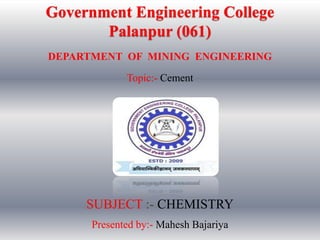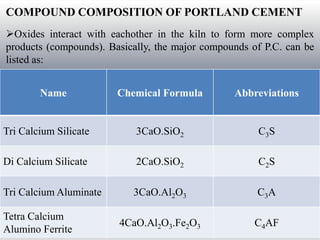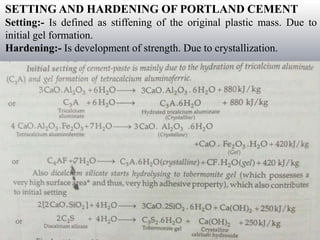Portland cement is manufactured by heating limestone and clay at high temperatures. It is composed mainly of calcium silicates and is used widely in construction materials like concrete and mortar. Cement production involves mixing raw materials, burning them in a kiln to form clinker, grinding the clinker, and adding gypsum. When cement powder is mixed with water, it undergoes hydration and hardens into a strong building material. Reinforced cement concrete combines cement with aggregates and steel reinforcement to make structures able to resist both compressive and tensile stresses.









![MANUFACTURE OF PORTLAND CEMENT
1) Mixing of raw material:-
(i) Dry process: The raw materials [Limestone (or chalk) and clay (or
shake)] are crushed (in gyratory crushers) into roughly 2-5 cm size
pieces. Then, these are ground to fine powder (in ball mills/tube mills).
Each separate powdered ingredient is stored in a separate hopper.
Then, the powdered materials are mixed in the required proportions to
get dry ‘raw mix’, which is stored in storage bins (called silos) and kept
ready to be fed in a rotary kiln.
Raw materials are mixed in calculated proportions so that the average
composition of the final product is as follows:](https://image.slidesharecdn.com/cement-191212125453/85/Cement-10-320.jpg)

![(ii) Wet process: The calcareous raw materials are crushed, powdered
and stored in big storage tanks (called silos). The argilaceous materials
(say clay) is thoroughly mixed with water in wash mills, to remove any
adhering organic matter, etc. The basin-washed clay is also stored.
Powdered limestone (from silos) and washed wet clay (from basins)
are allowed to flow in channel, in the right proportions. From the
channel, the two raw materials are led to ‘grinding mills’, where they
are mixed intimately to from a paste, called slurry [grinding operation is
carried out in either tube mill or ball mill or both].
The slurry is led to a ‘correcting basin’, where its chemical
composition may be adjusted, if necessary. This slurry contains about
38 to 40 percent water.
The slurry is finally stored tanks and kept ready for feeding to a
rotary kiln.](https://image.slidesharecdn.com/cement-191212125453/85/Cement-12-320.jpg)






